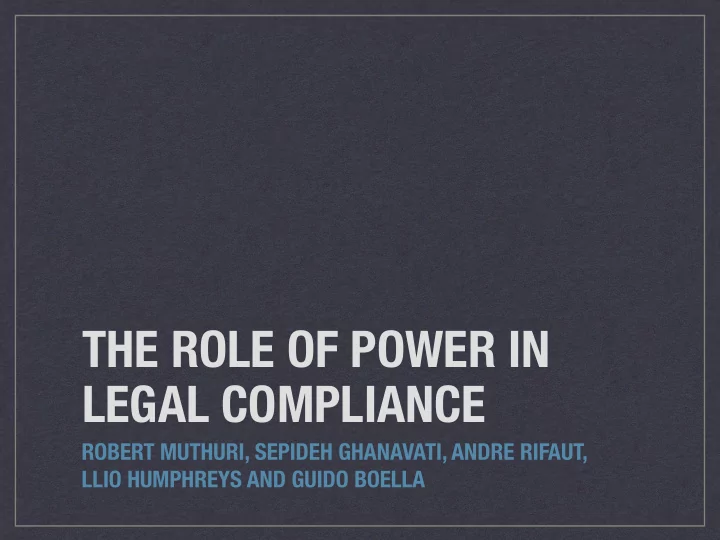

THE ROLE OF POWER IN LEGAL COMPLIANCE ROBERT MUTHURI, SEPIDEH GHANAVATI, ANDRE RIFAUT, LLIO HUMPHREYS AND GUIDO BOELLA
Norm conferring power in legislative text
Structured data used in compliance support systems
What is power? Power = the physical or mental capacity to achieve something Legal Power = the ability to change a legal relation (Hohfeld 1913)
Hohfeld’s legal relations (Sergot 2001)
Examples of legal power transfer property confer power to others create and terminate obligations confer permissions renounce power altogether
Examples of institutional power Only the student is empowered to register his chosen examination options Candidates for promotion can be put forward only by their section head The Chief Librarian is empowered to waive lending restrictions The Head of Department alone is empowered to assign duties to members of the department (Jones & Sergot 1996)
Generic Power “If A then B”: a direct reflex of the normative conditionality (Sartor & Pattaro 2005) Patients have the right to protection of their medical records and other personal health information.
Action power Involves an agent’s action in the antecedent of a normative connection (Sartor & Pattaro 2005) Wild beasts, birds, fish, that is all animals which live either in the sea, the air or on the earth, so soon as they are taken by any one, immediately becomes by the law of nations the property of their captor. Whoever culpably causes a damage to another’s property is obliged to compensate that person One has the action-power of initiating one’s own obligation to compensate?
Enabling power Where the agent intends to achieve the normative result (Sartor & Pattaro 2005) Member States may allow the airport managing body of an airport network to introduce a common and transparent airport charging system to cover the airport network This is the type of power that is most suited to the legal environment
Static power The static system references in-domain definitions of powers (Kelsen 1967) Patients have the right to protection of their medical records and other personal health information (Health Insurance Portability and Accountability Act) A patient is empowered to direct a covered entity to release his/her medical information (HIPAA)
Dynamic power Dynamic implicit power alters the deontic clauses at play at runtime. (Kelsen 1967) Patients have the right to protection of their medical records and other personal health information (HIPAA) A covered entity may disclose protected health information to authorized federal o ffi cials for national security activities authorized by the National Security Act (HIPAA) Elements of the Intelligence Community are authorized to collect, retain, or disseminate information that is publicly available or collected with the consent of the person concerned or needed to protect the safety of any persons or organizations (National Security Act)
Formalisation of laws in Prolog the operational layer – the set of actions that agents know and have the resources to perform the actions; the deontic layer – the set of permissions or obligations of agents issued from the first Hohfeldian square composed of the concepts of right, duty, privilege, and no-right the sanction layer – the impacts of non-compliance or forbidden behaviours the power layer - the second Hohfeldian square: modifications to the first three layers when agents play specific roles in the context of institutions. (Jones & Sergot 1995)
Formalisation of laws and business processes in Legal-URN
The interplay of obligations and power Section. 13402(a) Health Information Technology for Economic and Clinical Health Act: A covered entity (e.g. healthcare provider) that uses, or discloses unsecured protected health information shall notify each individual whose data has been accessed. Article 164.404(b) HIPAA: Except as provided in 164.412, a covered entity shall provide the notification required without unreasonable delay and in no case later than 60 calendar days after discovery of a breach. Article 164.412 HIPAA: If a law enforcement o ffi cial states that a notification would impede a criminal investigation or cause damage to national security , a covered entity or business associate shall delay such notification
Representation of obligations and power in Legal-GRL
Identification of power and permission in legislative text
Identification of power and permission in legislative text
References W. N. Hohfeld. Some fundamental legal conceptions as applied in judicial reasoning. 1913 G. H. Von Wright. Norm and action: a logical enquiry. 1963. H. Kelsen. Theory of the Dynamics of Law. 1967 A. Jones and M. Sergot. A formal characterisation of institutionalised power. 1996. M. Sergot. A computational theory of normative positions. 2001 . G. Sartor and E. Pattaro. Legal Reasoning: A Cognitive Approach to the Law. 2005 G. Boella, S. Colombo Tosatto, Sepideh Ghanavati, Joris Hulstijn, Llio Humphreys, Robert Muthuri, Andre Rifaut, and Leendert van der Torre. Integrating Legal-URN and Eunomos: Towards a Comprehensive Compliance Management Solution 2014
Recommend
More recommend